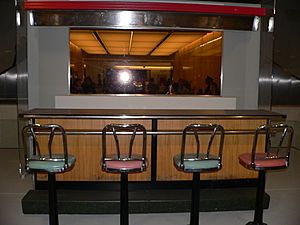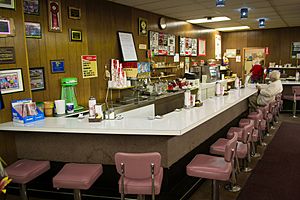Lunch counter facts for kids

A lunch counter was a type of small restaurant, usually found inside larger stores in the United States. Imagine a long table or "counter" with stools where customers would sit. A server or cook would stand on the other side, preparing and serving food. As the name suggests, these places were mainly for the lunch meal.
Lunch counters were very common in stores called "five and dimes" or "five and tens." These were variety stores that sold many different kinds of goods, often at low prices. The idea was to give hungry shoppers a place to eat, which would also encourage them to stay longer and buy more things from the store.
History of Lunch Counters
One of the first big stores to have a lunch counter was Woolworth's, a popular "five and dime" chain. They opened their first one in New Albany, Indiana, around 1923, and soon many more followed. Other similar stores like Newberry's and S. H. Kress also had them.
The people who worked at these counters were often regular store employees who had special training. They served simple, tasty food like hot and cold sandwiches (such as grilled cheese or BLT), soups, pie, and ice cream treats like sundaes and milkshakes. You could also get soda, coffee, and hot chocolate.
Lunch counters were very popular in the 1950s. But by the 1960s, they started to lose their popularity. This was partly because new fast-food restaurants like McDonald's became very popular. Also, convenience stores like 7-Eleven started to offer quick snacks. Another big reason for their decline was the important Civil Rights Movement.
Lunch Counters and the Civil Rights Movement
Lunch counters played a very important role in the Civil Rights Movement in the 1960s, especially in the Southern United States. At that time, many places had unfair rules called Jim Crow laws that kept Black people and white people separate. This was called racial segregation.
Many lunch counters had "whites only" sections, meaning Black people were not allowed to sit and eat there. To protest these unfair rules, African Americans and their supporters started "sit-ins." This meant they would sit at the "whites only" counters and refuse to leave until they were served. It was a peaceful way to demand equal rights.
One of the most famous sit-ins happened at the Woolworth's lunch counter in Greensboro, North Carolina, in 1960. This event, known as the Greensboro sit-ins, was a major moment in the Civil Rights Movement. It inspired many other protests across the country.
Today, a part of that historic Greensboro lunch counter is kept at the Smithsonian Institution's National Museum of American History. The old Woolworth's building in Greensboro is now the International Civil Rights Center and Museum, which teaches people about this important time in history.
Images for kids
pt:Lanchonete













